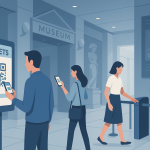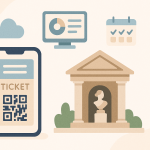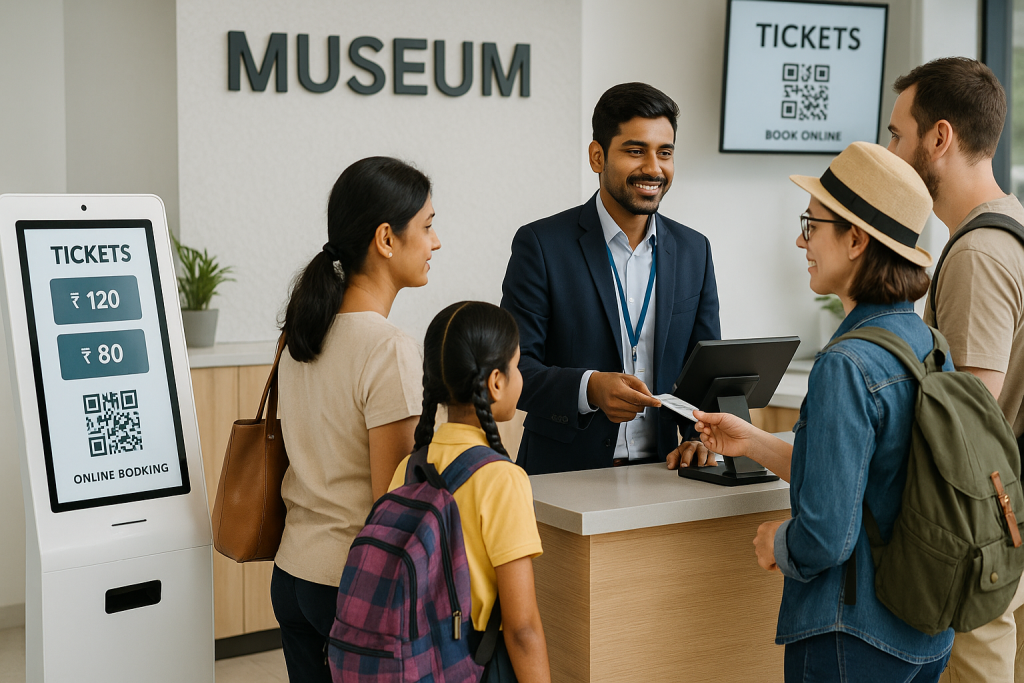Ticketing software for museums has long been missing from Indian institutions, which have traditionally operated using manual systems like paper ticketing, physical logbooks, and offline visitor registrations. While these heritage spaces continue to attract interest, their operational models often lag behind modern visitor expectations. The result? Long queues at entry gates, limited capacity for managing high footfall, and minimal visibility into visitor data.
This outdated approach not only hampers visitor experience but also leaves significant revenue on the table. With little ability to upsell memberships, analyze peak visiting times, or streamline group bookings, many museums struggle with flat or declining income, especially in the post-pandemic recovery phase.
This case study shows that Solutions like EveryTicket, trusted by leading museums such as MAP Bangalore, have processed over 115,000 tickets and completed 54,000+ online bookings, demonstrating the growing demand for digital experiences among Indian and international tourists.
One such platform leading this change is EveryTicket, a customized solution built specifically for Indian museums. With features tailored for local challenges from multilingual interfaces to compliance with Indian payment systems, EveryTicket is helping museums reimagine the way they manage admissions, track visitors, and boost revenue.
As we explore this transformation, it becomes clear that digital ticketing is not just a convenience, it’s a strategic lever for financial growth and sustainable operations.
What are Common Challenges in Museum Operations
Despite their cultural significance and growing tourism interest, many Indian museums continue to operate with outdated infrastructure. The lack of a robust museum ticketing system creates several pain points that hinder both day-to-day operations and long-term sustainability.
One of the most glaring issues is the absence of a reliable online ticketing infrastructure. Visitors are often required to purchase tickets in person, leading to long queues, manual cash handling, and potential errors. In a world where consumers expect digital convenience, this gap significantly impacts visitor satisfaction and footfall especially among younger, tech-savvy audiences and international tourists.
Beyond ticketing, most museums lack centralized systems for managing visitor data. Without a dedicated museum visitor management system, institutions are unable to gather insights on who their audiences are, when they visit, or how they interact with exhibits. This means lost opportunities for personalized engagement, targeted promotions, or educational outreach.
Manual processes also extend to backend reporting. Most museums rely on handwritten logs or basic spreadsheets to track admissions and revenue, which leads to inefficiencies, inconsistencies, and a lack of real-time data for decision-making.
Moreover, with limited or no integration with marketing tools or CRM platforms, museums miss out on the ability to nurture relationships with past visitors or convert them into repeat guests or donors.
The solution lies in adopting purpose-built museum ticketing software India needs tools that combine admissions, visitor analytics, and communication under one roof. Modern museum admissions software can bridge these operational gaps and provide a digital foundation for smarter, more connected museum experiences.
What Is Tailored Ticketing Software for Museums?
Tailored ticketing systems for museums are purpose-built platforms designed to address the specific operational, financial, and visitor engagement needs of cultural institutions. Unlike generic event or ticketing tools, these customized museum ticketing platforms offer an end-to-end solution covering everything from online bookings to visitor analytics and CRM integration.
At their core, such systems include:
- Seamless museum booking software for individual, group, and timed-entry tickets
- Mobile-friendly interfaces for both staff and visitors
- Real-time analytics on footfall, revenue, and operational efficiency
- CRM tools for personalized communication, membership renewals, and promotional campaigns
- Integrations with access control, payment gateways, and government ID systems
By adopting digital ticketing for museums, institutions can not only modernize how tickets are sold but also how relationships with visitors are built. This shift enables smarter planning, better crowd control, and more meaningful post-visit engagement something manual systems can’t offer.
Generic ticketing software often lacks the flexibility to handle museum-specific workflows, such as coordinating with exhibit schedules, handling multilingual visitor journeys, or accommodating school group bookings. In contrast, tailored platforms are designed with these nuances in mind.
To understand how this kind of digital infrastructure transforms museum operations, this guide on integrating museum ticketing software offers a practical overview of implementation and impact.
Ultimately, customized solutions empower museums to go beyond basic admissions and build a truly connected, data-driven visitor experience.
Case Study Snapshot: Before & After – Real Impact on Revenue
As cultural institutions increasingly turn to ticketing software for museums to streamline operations, improve visitor engagement, and unlock sustainable revenue growth. This transformation is best understood through real-world examples including standout results from MAP Bengaluru and other anonymized case studies across South India and Rajasthan.
Before Implementation: Outdated Systems and Revenue Leakages
Prior to adopting modern digital systems, many Indian museums operated under heavy administrative strain. A state-run art museum in South India and a popular heritage fort museum in Rajasthan both faced mounting issues: long queues during weekends, cash-only ticketing prone to leakages, and limited outreach to digital-first audiences. These challenges translated into missed revenue opportunities and a disconnected visitor experience.
Without access to reliable museum admissions software or a proper museum ticketing system, institutions had no way to gather visitor insights or manage real-time demand. Marketing capabilities were basic, and tracking repeat visitors or promoting events was mostly manual and ineffective.
After Implementation: Revenue Growth, Data Insights & Streamlined Experience
The adoption of digital ticketing systems for Indian museums brought measurable improvements. At MAP Bengaluru, the implementation of a modern ticketing platform resulted in a 40% increase in ticket sales. Visitors embraced the ease of online bookings, and QR-based entry points cut wait times by nearly 30%. Real-time analytics enabled the museum to better understand visitor demographics and behavior fueling smarter event planning and personalized marketing.
Similarly, the South Indian and Rajasthani museums witnessed 30–40% growth in ticket revenue after introducing museum ticketing software India was lacking. The shift to digital payments not only prevented revenue leakages but also ensured complete, auditable transaction histories. With integrated CRM functionality, museums could track attendance trends, manage membership programs, and build lasting relationships with their audiences.
For a deeper look at how digital platforms are reshaping Indian museums, refer to this article on how digital ticketing transforms museums.
Key Takeaways: Digital Ticketing’s Impact on Indian Museums
- Museum Revenue Optimization: Dynamic pricing and online upselling (e.g., guided tours, combo tickets) have significantly boosted income.
- Museum Ticket Sales Improvement: Mobile-first bookings reduced no-shows and made advance reservations frictionless.
- Customized Museum Ticketing Platforms: Localized solutions ensured better integration with Indian payment systems, languages, and workflows.
- Museum Ticketing Case Study India: Institutions across states are now case studies in successful digital transformation, thanks to tailored solutions.
These real-world examples demonstrate that embracing digital ticketing for museums is more than a tech upgrade, it’s a revenue growth strategy, a visitor experience enhancement, and a foundation for long-term operational success.
What are Features That Made the Difference
The success of digital transformation in Indian museums can be traced directly to the specific capabilities of the modern museum ticketing solutions they adopted. These platforms aren’t just digital replicas of paper systems, they are thoughtfully designed to meet the evolving needs of both visitors and museum staff.
One of the most significant upgrades is the ability to offer online bookings and QR-based entry. This eliminates long queues and allows visitors to plan their visit in advance, a key improvement for tourist-heavy museums and cultural sites. QR code scanning at entry points speeds up access, improves crowd flow, and minimizes the need for physical contact, especially important in a post-COVID world.
Another standout feature of modern museum ticket software is seamless integration with government ID systems and provisions for foreign visitor registration. This ensures compliance with local policies while simplifying check-in processes, particularly for heritage and state-run museums that require identity verification.
Advanced real-time analytics dashboards allow museum operators to track daily attendance, peak hours, revenue performance, and visitor demographics at a glance. This data-driven approach empowers museum leaders to make informed decisions about staffing, scheduling, and exhibit planning.
In addition, integrated CRM tools and built-in email/SMS campaign features allow museums to engage visitors beyond the entry gate. From sending booking confirmations to sharing exhibit announcements and collecting feedback, communication becomes more strategic and personalized.
These features collectively demonstrate the clear ticketing platform benefits for museums from operational efficiency to stronger visitor relationships. Institutions that implement online museum ticketing solutions not only modernize their systems but also unlock new pathways to long-term growth and audience retention.
Why Indian Museums Need Localized, Scalable Solutions
While several global platforms offer ticketing tools for cultural institutions, many fall short when applied to the unique operational landscape of Indian museums. From regional language diversity to local compliance requirements and fluctuating visitor flows, international software often lacks the adaptability Indian museums need to function efficiently at scale.
For example, most global tools are designed with Western infrastructure in mind, assuming high credit card penetration, minimal identity verification, and smaller group sizes. But in India, where museums often see school groups, multilingual visitors, and walk-ins who prefer UPI or cash alternatives, a one-size-fits-all model simply doesn’t work.
This is where purpose-built museum ticketing software India institutions require comes into play. Platforms like Every Ticket are designed from the ground up for Indian museums offering vernacular language support, customizable pricing slabs for citizens and foreigners, and integration with local payment gateways and ID systems.
Additionally, ticketing systems for Indian museums like Every Ticket offer flexibility in deployment from cloud dashboards to on-site kiosks ensuring scalability for institutions of all sizes, whether they’re a national museum or a local heritage site.
By adopting solutions rooted in the realities of the Indian ecosystem, museums can truly unlock the power of digitization without compromising cultural context or operational efficiency
What are Future Trends in Museum Ticketing in India
As museums in India continue their digital evolution, the next phase of growth will be driven by advanced technologies that not only streamline operations but also enhance the overall visitor experience.
One of the most promising trends is the use of AI-powered visitor insights. By analyzing attendance patterns and visitor behavior, museums can personalize outreach, improve exhibit planning, and ultimately contribute to increasing museum revenue.
Emerging technologies like AR/VR-based experiences are also being integrated into museum booking software, offering immersive storytelling and interactive exhibits that appeal to younger audiences and global tourists alike.
Smart queue management and access control systems will soon become standard, helping manage crowds efficiently during peak hours and ensuring a seamless check-in experience.
Lastly, strategic partnerships with tourism platforms including travel aggregators and hotel networks are helping drive revenue growth for museums through bundled experiences and pre-arrival bookings.
These innovations, combined with robust digital payments (as explored in this guide on revenue leak prevention), signal a future where Indian museums are not just preservers of history but pioneers in digital engagement.
Conclusion: Takeaways from the Case Study
This case study clearly shows that with the right ticketing software for museums, Indian institutions can overcome traditional barriers and step into a future of digital excellence. From operational efficiency and real-time insights to increased sales and better visitor experiences, the transformation is tangible.
By choosing platforms purpose-built for local needs, museums can ensure long-term sustainability and relevance in an increasingly competitive cultural tourism landscape.
Looking to transform your museum experience? Learn how EveryTicket can help you modernize and grow.



